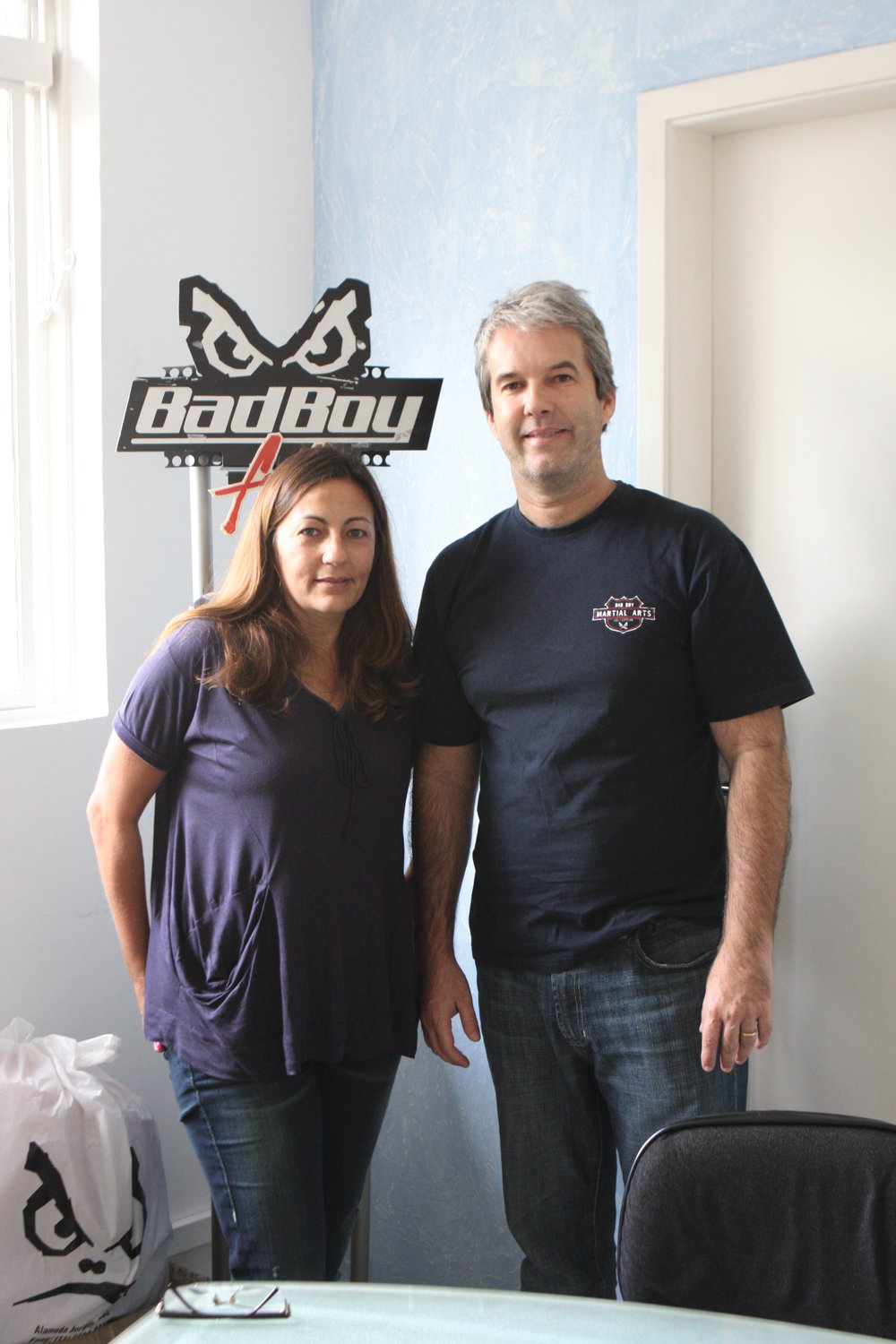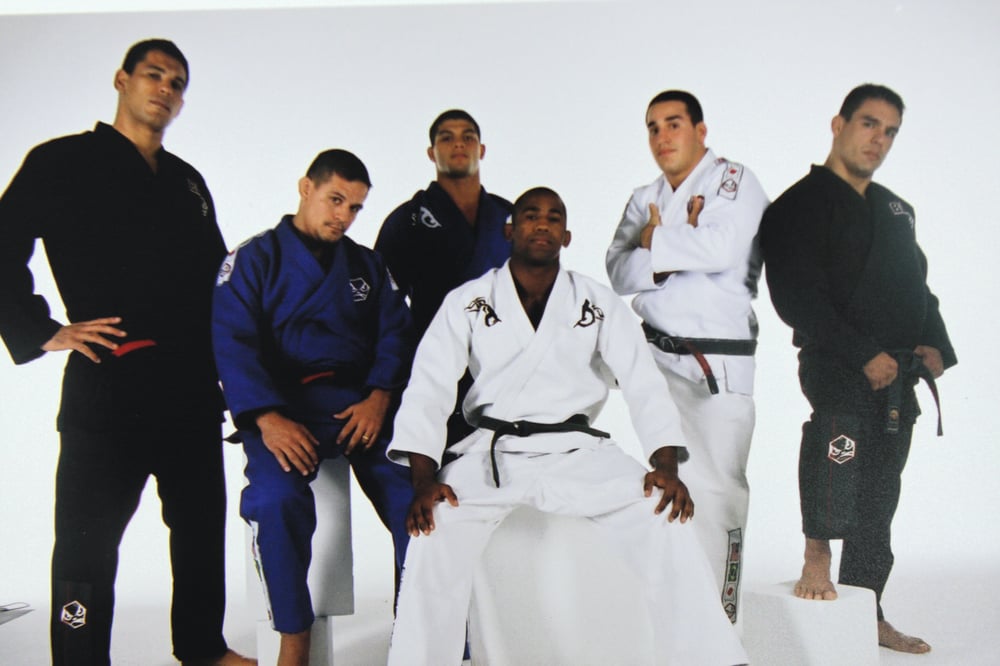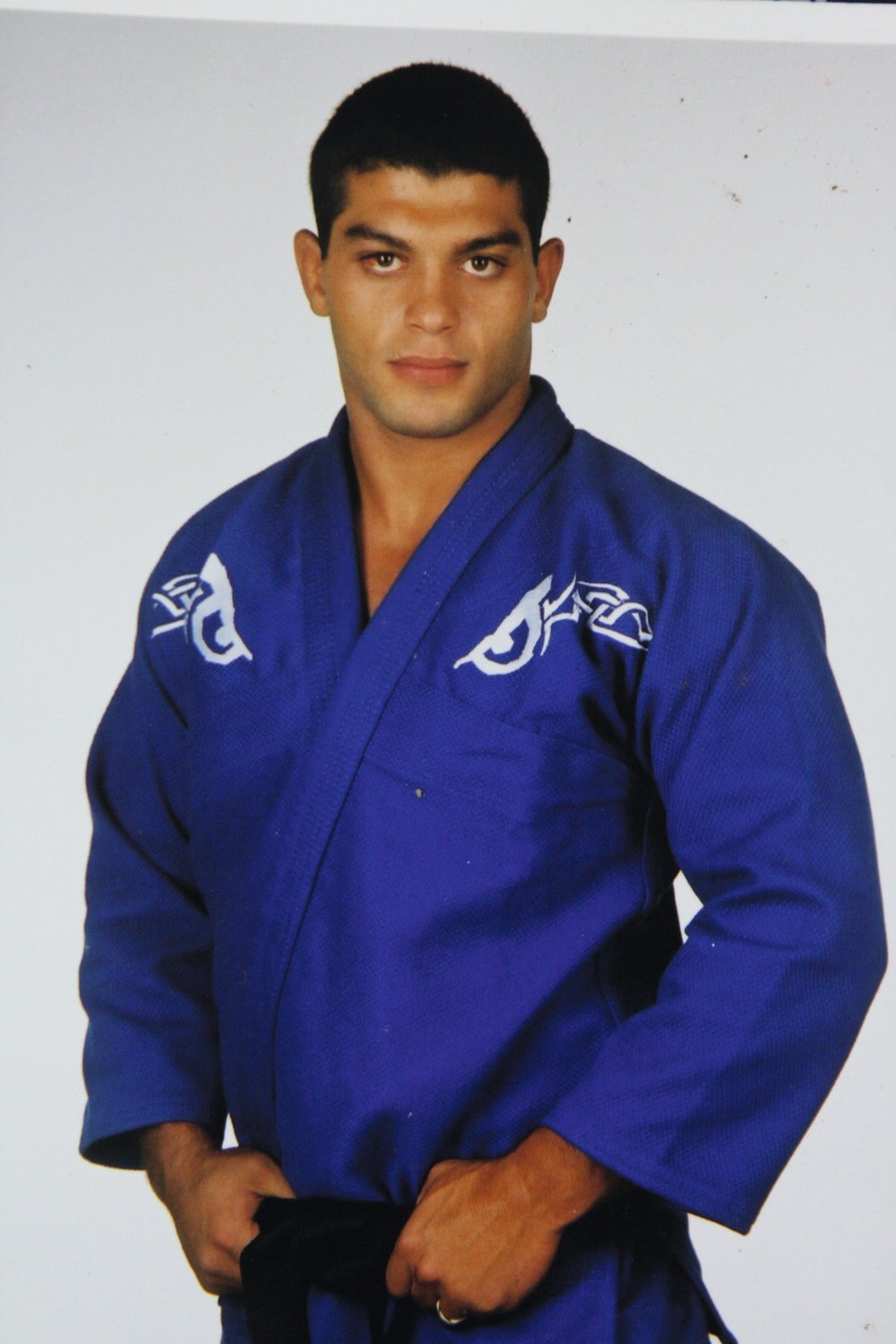
Issue 064
July 2010
Today MMA is a sport recognized worldwide, and there are hundreds of fight wear brands eager to capitalize on the success of major promotions such as the UFC, but back in the ‘90s it was a different tale altogether.
While ‘extreme sports’ such as surfing were very popular, MMA was an underground activity, prohibited in most states across the USA. But in Brazil, the growth of jiu-jitsu (which gained popularity thanks to Royce’s wins in UFC) caught the attention of two businessmen involved in surf wear. They decided to invest in this new, growing market, and imported a surf brand from San Diego to the beaches of Brazil.
That was the beginning of Bad Boy, the first brand to make the crossover from extreme sports to MMA, and who dominated the market for almost a decade. To find more about the history of the brand with the famous ‘evil eyes’ logo, we went to Sao Paulo (site of Bad Boy’s head office in Brazil) where the story began.
During the 1980s and the beginning of 1990s, surf fever consumed Brazil. Everywhere you looked, you could see a teenager wearing a surf brand, a clear influence from California and Hawaii.
In Rio de Janeiro, most jiu-jitsu fighters could also be found down on the beach. The association between surfing and jiu-jitsu was a natural one and COMPANY (a very famous surf brand by that time) sponsored three editions of the Copa Company jiu-jitsu championships. These competitions were instrumental in launching the great talents of the sport in the 1980s, grapplers such as Rickson Gracie, Fabio Gurgel, Renzo Gracie, Murilo Bustamante, Wallid Ismail and many others.
At that time there was a huge rivalry between jiu-jitsu and rival grappling style luta livre, with battles taking place on the streets of Rio. To avoid further fights on the streets, leaders of both groups decided to make a vale tudo challenge (luta-livre x jiu-jitsu). In that event, held on September 26 1991, a jiu-jitsu squad (comprising Fabio Gurgel, Murilo Bustamante and Wallid Ismail) defeated three challengers from luta livre (Denilson Maia, Marcelo Mendes and Eugenio Tadeu). The bloody challenge was broadcast all over the country by Rede Globo TV and, from that point on, jiu-jitsu became very popular among teenagers.

The beginning of Bad Boy
Marco Antonio Merhej and Nair Afonso owned the surf wear brand ST COMP. They went to San Diego in the summer of 1992 to gather news and developments from the ‘mecca’ of the surf world, just as they did every year. “We saw in a surfing magazine an advertisement for a brand called ‘Life is a Beach’. Marco went there, met the owners and convinced them to bring it to Brazil. Together with Life is a Beach, this guy also had Bad Boy and Bad Girl, which were very small brands back in 1992,” recalls Nair Afonso, who was at the time both wife and business partner of Marco (today they are purely business partners).
In 1993, Royce Gracie won the first UFC and jiu-jitsu started gain popularity in Brazil. “While the surf market was saturated, the fighting market was a new venture and needed a brand with attitude – so we felt it was time to invest,” recalls Nair. In the beginning, to run alongside the classic ‘Fear Me’ (the face logo designed by the owners of the brand in San Diego), Nair and Marco decided to make some funny T-shirts featuring sex as the main subject, and telling people not to drink and drive. “Joining humor, sex and attitude, Bad Boy started to be popular among teenagers,” remembers Roberto Silveira, director of the Brazilian branch since the beginning.
Another turning point for Bad Boy was the seminar given by Rickson and his brother Royler in Sao Paulo. “Rickson was the biggest idol in jiu-jitsu. He came to Sao Paulo and was on the cover of Kiai magazine (the biggest martial arts magazine in Brazil at the time) wearing a Bad Boy gi. The whole jiu-jitsu community were interested and wanted to become sponsored by Bad Boy. After that we started to sponsor Marcelo and Sylvio Behring, and soon we got the biggest teams in Brazil,” recalls Roberto.

Jiu-jitsu and surfing
With an amazing debut in the jiu-jitsu community, Bad Boy decided to sponsor the first Pan American games in 1995, as promoted by the CBJJ (Brazilian Jiu-Jitsu Confederation) in Hawaii. “The natural connection between surfing and jiu-jitsu made us promote a surfing tournament, right after the Pan-Americans, only with black belts, on Sunset beach. To make that, we counted on the support of the famous surfer Fast Eddie [one of the founding members of Da Hui, a tribe of Hawaiian surfers famous for wearing black shorts], a big admirer of the Gracie family. He cleaned up Sunset Beach for us. I remember that Rickson got the second place [in the surfing tournament],” recalls Roberto.
In Brazil, Bad Boy was growing and investing in the world of fighting. In the USA, it hit its peak with the sponsoring of Johnny Boy Gomes, the famous Hawaiian who was also known as Jonny ‘Bad Boy’ Gomes. “The creative department in the USA were giving more strength to surfing while the fighting in Brazil started to grow, so the designs here started to be related to fighting. By that time we created the bad face symbol [eyes and mouth]. That started to be our most notorious symbol in MMA,” explains Silveira.
By 1997 the Bad Boy brand had became so famous in Brazil that it was synonymous with vale tudo and jiu-jitsu. “There was a time that it was pretty common to see fighting in the night clubs of Rio de Janeiro. Most of them wore Bad Boy T-shirts because it was pretty much in fashion at that time. The press started to call those guys “bad boys” or “pit boys.” If we had a soccer player with bad attitude or some villain in the most popular soap opera, they were immediately nicknamed bad boys. It was not good for us, so we decided to make a campaign to unlink the Bad Boy name from those guys who had a bad attitude. We wanted to show that our fighters could be bad boys inside the ring, but outside they had to show a nice image, so we made a campaign with our fighters that if their students fought in the streets, they would be banned from the academy. We also made a campaign ‘Bad Boy don’t use drugs’. Little by little we changed that bad image,” explains Nair.

Supporting American fighters
In 1997, the UFC was suffering a crisis and was banned in many states across the USA. On the other hand, Pride started to grow in Japan, while in Brazil Sergio Batarelli and Frederico La Penda started to promote IVC, bringing many American fighters to fight in Brazil. “By that time Mario Yamasaki started to bring Coleman, Kerr, Randleman, Tom Erikson and many other fighters to us,” recalls Roberto, revealing that the relationship was not really very professional. “They didn’t have any sponsorship in the USA, so we started to give them our stuff. We took them to barbecue places and gave them many Bad Boy clothes, and they would leave very happy using our clothes. Actually we started to have a great relationship with most of them. For example, when Kerr hurt his hand fighting Mestre Hulk, we took him to the hospital,” remembers Roberto.
When UFC came to Brazil in 1998, Bad Boy sponsored most of the Brazilian fighters. But other brands had started to appear, such as Red Nose (who sponsored Wanderlei Silva). The fight that attracted the most local attention on UFC Brazil was that between Wanderlei (Red Nose) and Vitor Belfort (Bad Boy). When Belfort knocked Wanderlei out in a few seconds, Bad Boy scored a major victory over their strongest opponent.

The second generation
MMA started to take off in Japan with Pride, and Bad Boy sponsored names such as Rodrigo ‘Minotauro’ Nogueira and Ricardo Arona, as well as big stars in the jiu-jitsu world such as Saulo Ribeiro, Fernando Terere and Fernando Margarida. “At the peak we started to have more than 80 fighters representing jiu-jitsu, boxing, capoeira, taekwondo, surfing and skating,” tells Nair.
The huge number of sponsored athletes and the increasing number of competitor brands (such as Hunter, Red Nose and many others) made Bad Boy file for bankruptcy in 2001. “In order to survive we had to change our focus – instead of producing clothes in our own factory and distributing them, we started to license our products. Grandene started to make our sandals, Mach started to make our underpants, Meltex started to produce our backpacks and Jandaia started to manufacture our notebooks,” explains Roberto Santana.
In the Brazilian MMA market the famous Bad Boy logo all but disappeared, and most people thought that they were done with. But in 2005, Bad Boy started to be seen again. “The American Bad Boy team have done a lot of research on how the American fans saw their brand, and they found out that it was seen as a top Brazilian MMA brand. After that, the main office in USA joined all the licensees [Brazil, Australia, Japan and South Africa] and we started a marketing fund to invest in a top MMA team, which today comprises Mauricio ‘Shogun’ Rua, Junior Dos Santos and Demian Maia. Of course, everyone has his own local team in each country, but these three are paid by the world fund of Bad Boy,” explains Roberto.
Today, Bad Boy’s office in Brazil is located in Sao Paulo in a big building of two floors with 15 employees. The first floor houses the creative team, who work on new designs for the Bad Boy and Bad Girl ranges. Led by director Roberto Santana, the second floor has the big bosses Nair Afonso and Marcos. “Today we are growing little by little again. We are very proud to have started this new range of fight wear. Today there are hundreds of top brands like TapouT, Affliction and many others, but Bad Boy will always have its place because we made history, and our name will be always connected with the history of MMA.”
A WORD FROM THE TOP
Robin Offner, CEO of Bad Boy, outlines the driving principles behind one of the world’s most respected MMA brands.
On Bad Boy’s involvement with MMA
“We started MMA in 1993 and we’ve always maintained a strong relationship with the sport. The focus of the US branding platform did not turn to MMA until the last few years. We made a decision to re-launch the brand and reformat the US brand into an MMA brand, and that coincided with the explosion of MMA in the USA through the UFC. We’re a boat riding along down the river, and suddenly the river got bigger and faster along with the UFC and our boat is just moving along with it.”
On Bad Boy’s relationship with the fighters
“It was a philosophy that we always wanted to maintain our core relationship with MMA, and it begins with the athletes. I truly want to carry on the work of the Brazilian licensees – the fighters come first, they’re part of the family, and we owe our brand strength in MMA to the fighters. We built long-term relationships with our fighters, early on in their careers, and the fighters are very special to us.”
On sponsoring fighters
“We only sponsor fighters we have a relationship with. We have a very specific criteria for fighters we sponsor; they have to be great fighters, great citizens and great teammates. They have to want to be a part of the Bad Boy family.”
On the Bad Boy logo
“The logo began as a California surf and skate logo in the late ‘80s, and in the early ‘90s it was a muscleman guy with spiked hair making a fist. We revised the logo to be a snarling eyes and mouth. That logo began to be applied to MMA by just taking the eyes and putting them on the shorts – that became our Nike swoosh. More recently, we’re using the eyes in a letterboxed format – even that goes through revisions to make it more trendy and hip. It goes through revision but it stays true to the core.”
On working with the community
“We organize charity events for the fighters, and they love to help reach out to the community and meet underprivileged kids. A lot of the Brazilian fighters came from nothing, they were very underprivileged, and they enter the commercial world of what MMA is becoming, and the good citizens want to give back to the community. Bad Boy has also supported people who support us. Inner-city kids get good grades, they email us their report cards and we send them some T-shirts. We have many informal programs where we give something back – you can’t just be in business and make money and not give something back to the people who made you a success. Bad Boy is all about giving back to the community.”
FIGHTERS TALK ABOUT BAD BOY
“In the ‘90s to be sponsored by Bad Boy meant you were among the elite of the sport, and I’m proud for being sponsored by them for many years.”
Wallid Ismail
“Today MMA is a great investment for anyone who wants to make money with fight wear. But when the sport was, in the beginning, seen as an underground activity by most people, Bad Boy was one of the few brands who invested in the sport – I’m proud of being part of this team.”
Ricardo Arona
“When I started to practice jiu-jitsu, I always saw the best fighters being sponsored by Bad Boy – today I’m proud to be part of this team.”
Demian Maia
...









